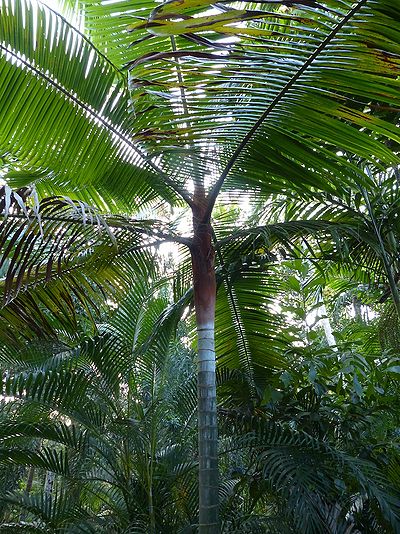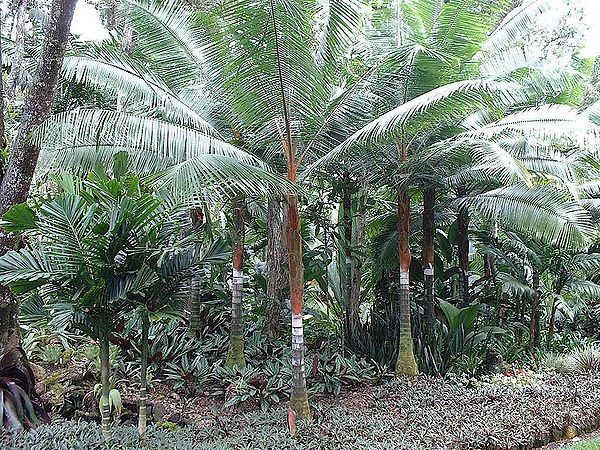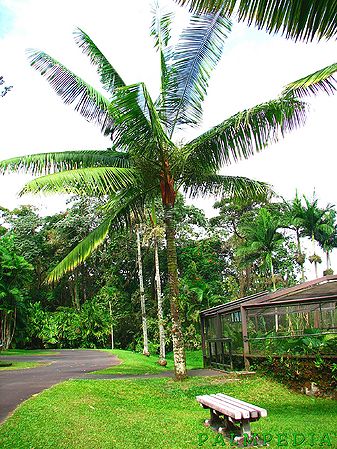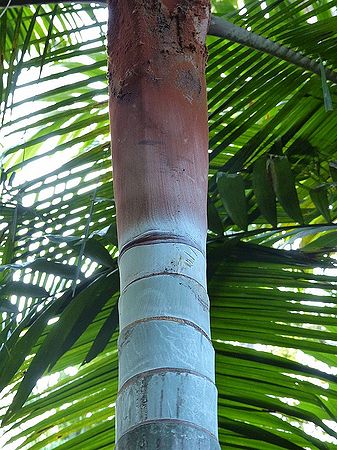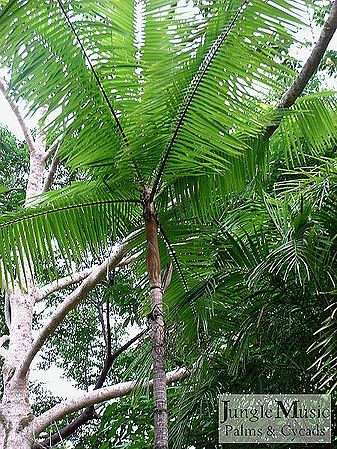Difference between revisions of "Chrysalidocarpus leptocheilos"
(re classification) |
|||
| (84 intermediate revisions by 3 users not shown) | |||
| Line 1: | Line 1: | ||
| − | + | <big>__noeditsection__ | |
| − | + | "Teddy Bear Palm"</big> | |
| − | + | {{Palmbox | |
| − | + | |image=DlDSC_1690.jpg | |
| − | + | |image_caption=Gold Coast, Hinterland, Queensland. Photo by Daryl O'Connor | |
| − | + | |genus=Chrysalidocarpus | |
| − | + | |species=<br>leptocheilos (lehp-toh-KAY-lohs) | |
| − | + | |subspecies= | |
| − | + | |cultivar= | |
| + | |synonyms= | ||
| + | |continent=africa | ||
| + | |habit=Solitary | ||
| + | |leaf_type=Pinnate | ||
| + | |height= | ||
| + | |trunk_diameter= | ||
| + | |sun_exposure= | ||
| + | |watering= | ||
| + | |soil_type= | ||
| + | |msi= | ||
| + | |common_names=Teddy Bear palm | ||
| + | }} | ||
==Habitat and Distribution== | ==Habitat and Distribution== | ||
| − | + | Said to occur in West Madagascar, but no voucher specimens from the [[File:post-6735-0-26729600-1429352639.jpg|thumb|left|400px|Sri Lanka. Photo by Philippe.]]wild are known. (1995). | |
==Description== | ==Description== | ||
| − | A medium sized, solitary palm with distinct rusty brownish-orange colored [[crownshaft]] that sports a fuzzy [[tomentum]] from which it's common name, The Teddybear Palm, comes from. The trunk can swell to a girth of about 6 inches and is distinctly ringed with the newest parts being green covered in a white powder. The leaves are exceptionally long with virtually no [[petiole]]. Often the [[leaflets]] get bent around in the wind and are held at various angles giving this palm a bit of a disheveled look, but the overall beauty is still not | + | A medium sized, solitary palm with distinct rusty brownish-orange colored [[crownshaft]] that sports a fuzzy [[tomentum]] from which it's common name, The Teddybear Palm, comes from. The trunk can swell to a girth of about 6 inches and is distinctly ringed with the newest parts being green covered in a white powder. The leaves are exceptionally long with virtually no [[petiole]]. Often the [[leaflets]] get bent around in the wind and are held at various angles giving this palm a bit of a disheveled look, but the overall beauty is still not compromised. (J. Dransfield and H. Beentje. 1995)/Palmweb. |
| + | |||
| + | Solitary palm. TRUNK to 10 m high, 25 cm in diam., slightly flared at the base; internodes 12 cm, nodal scars 2 cm, white. LEAVES about 15 in the crown, porrect; sheath partially open in outer leaves, about 62 cm long, 5 mm thick, covered in dense rusty brown tomentum, with auricles 3.5 cm high; petiole 17 cm long, 7-9 cm wide, channelled adaxially, densely tomentose but glabrescent; rachis to 4 m long, proximally channelled and tomentose, more distally becoming flattened and eventually keeled distally, glabrous distally; pinnae up to 103 on each side of the rachis, regular, slightly drooping, green, linear, straight, acuminate, the proximal 55 x 0.5-0.8 cm, median 85 x 4 cm, distal 55 x 0.5-0.8 cm, glabrous but for some ramenta on the proximal part of the midrib abaxially, main veins 3. INFLORESCENCE interfoliar becoming infrafoliar in fruit, branched to 3 orders, to 1.7 x 1.4 m; peduncle to 65 cm long, 11 cm in diam. proximally, 3-6 cm in diam. distally, flattened, reddish tomentose over green; prophyll ± woody, about 43 cm, borne at 12 cm above the base of the peduncle, about 12 cm wide, tomentose; peduncular bract deciduous, woody, inserted at 26 cm from the base of the peduncle, to 70 x 10-15 cm, reddish tomentose; two smaller peduncular bracts present near the apex of the peduncle, to 17 cm long, tomen-tose; rachis 100 cm, flattened, grey-tomentellous, with 24 first order branches; rachis bracts to 3 cm long; rachillae spreading, to 30 cm long, 3 mm in diam., green; with distant triads in pits; rachilla bract 0.5-0.75 mm high. STAMINATE FLOWERS with sepals 2-2.5 mm, keeled, truncate; petals on a 1 mm high receptacle, 2 x 1.5-1.75 mm, ovate, acute; stamens said to be connate for 1.75 mm, filaments 0.8-1 mm long, anthers 1 mm long, dorsifixed?; pistillode 1.75-2 mm, columnar. PISTILLATE FLOWERS with sepals 2 mm; petals 3 x 3 mm; gynoecium 4 mm high, 2-2.5 mm in diam., with 1 mm long stigma lobes. FRUIT globose, dark brown, 10-12 mm; endocarp fibrous, the fibres anastomosing rather intensely. SEED 8.5-10 x 8.5-9 mm, globose, pointed at the base, rounded at the apex, with a subbasal depression corresponding to the embryo; ruminations of the endosperm irregular, to 3.5 mm deep and up to half the diameter of the seed wide. EOPHYLL pinnate. Close to D. lastelliana but differs in rachilla bract (thinner in leptocheilos), and fruit/seed size. (J. Dransfield and H. Beentje. 1995)/Palmweb. Editing by edric. | ||
| + | |||
| + | Close to D. lastelliana but differs in rachilla bract (thinner in leptocheilos), and fruit/seed size. Differences enumerated in the protologue with another species of Dypsis (it is unclear which one). (J. Dransfield and H. Beentje. 1995)/Palmweb. | ||
==Culture== | ==Culture== | ||
| − | Loves water and responds well to fertilizer. Grows in bright filtered light to full sun but can get leggy and ratty looking if grown in lower light levels, therefore full sun tends to produce a more beautiful palm. Can handle a light frost with damage but usually will recover with no lasting effects. | + | Loves water and responds well to fertilizer. Grows in bright filtered light to full sun but can get leggy and ratty looking if grown in lower light levels, therefore full sun tends to produce a more beautiful palm. Can handle a light frost with damage but usually will recover with no lasting effects. Cold Hardiness Zone: 10a |
| − | ==Curiosities== | + | <center> |
| + | [[{{PFC}}http://www.palmpedia.net/palmsforcal/index.php5/Dypsis_leptocheilos]] | ||
| + | </center> | ||
| + | ==Comments and Curiosities== | ||
Some ''D. leptocheilos'' exibit a [[heel]] and some don't. | Some ''D. leptocheilos'' exibit a [[heel]] and some don't. | ||
| − | [[Category: | + | |
| + | Conservation: Unknown, until the status in the wild has become more clear. (J. Dransfield and H. Beentje. 1995)/Palmweb. | ||
| + | |||
| + | <br clear="all"> | ||
| + | {{#Widget:AdResban}} | ||
| + | <center><gallery caption="IMAGE GALLERY" perrow="" widths="" heights=""> | ||
| + | Image:Dypsis_leptocheils_and_D_lastelliana_nearby.jpg|Hawaii. D. lastelliana on left. | ||
| + | Image:Dyp lepto crn.jpg|Kona, Hawaii. | ||
| + | Image:Dyp lepto lf.jpg|Kona, Hawaii. | ||
| + | Image:Dyp lep grp.jpg|Hawaii. | ||
| + | Image:Dypsis leptocheilos in zoo lighter.jpg|Panaewa Zoo - Hilo, Hawaii. | ||
| + | Image:Dyp lep ov.jpg|Australia. | ||
| + | Image:Dypsis leptocheilos crownshaft.jpg|Red Fuzzy Tomentum. | ||
| + | Image:Dypsis leptocheilos trunk.jpg|Hawaii. | ||
| + | Image:5294697049_03c772f8e6_dyplep.jpg | ||
| + | image:Img_1037hpleugardensz.jpg|H. P. Leu Gardens, Orlando, FL. Photo by H.P. Leu Gardens Botanist Eric S. | ||
| + | image:GBPIX_photo_187645z.jpg|New Caledonia. Photo by Ben | ||
| + | image:GBPIX_photo_187656z.jpg|New Caledonia. Photo by Ben | ||
| + | Image:IMG_4598.jpg|edric, Oak Hill FL. | ||
| + | image:Dypsis-leptocheilos-crownshaft-1z.jpg | ||
| + | image:Dypsis-leptocheilos-crownshaft-2z.jpg | ||
| + | image:Leptocheilos10z.jpg|Photo by Simon van Heel | ||
| + | image:Leptocheilos03z.jpg|Photo by Rolf Kyburz | ||
| + | image:Leptocheilos04z.jpg|Photo by Rolf Kyburz | ||
| + | image:Dac707socalz.jpg|SoCal. | ||
| + | image:D70cbbz.jpg|Singapore botanical gardens | ||
| + | image:1ab193.jpg | ||
| + | image:3aa98fhawaiiz.jpg|Hawaii. | ||
| + | image:3f538bhawaii.jpg|Hawaii. | ||
| + | image:92a392singz.jpg|Singapore botanical gardens. | ||
| + | image:678de7hawaiiz.jpg|Hawaii. | ||
| + | image:388171hawaiiz.jpg|Hawaii. | ||
| + | image:B33128.jpg|Hawaii. | ||
| + | image:F26715singz.jpg|Singapore botanical gardens. | ||
| + | image:PeteDSCN5835.jpg|Mt Warning Caldera. Nth NSW Australia. Photo by Pete | ||
| + | image:-gallery-members-teddyb2z.jpg|The Naples Botanical Gardens, Naples Italy, photo by Jerold Crawford | ||
| + | image:43035f0c-3098-456a-b5c9-ea011ac3fd8ez.jpg|Daintree, Queensland, Australia. Photo by Dr. John Dransfield, Royal Botanic Gardens, Kew/Palmweb. | ||
| + | image:644cceb0-cc81-450c-9cfb-b7c1a0c8981ez.jpg|Daintree, Queensland, Australia. Photo by Dr. John Dransfield, Royal Botanic Gardens, Kew/Palmweb. | ||
| + | image:B35985c4-9aab-4395-a802-09a67662c788z.jpg|Tahiti, French Polynesia. Photo by Dr. Hodel/Palmweb. | ||
| + | image:DlDSC_1690.jpg|Gold Coast, Hinterland, Queensland. Photo by Daryl O'Connor | ||
| + | image:DlP1080382.jpg|Gold Coast, Hinterland, Queensland. Photo by Daryl O'Connor | ||
| + | File:post-42-0-20898500-1419937975.jpg|Gold Coast, Hinterland, Queensland, Australia. Photo by Daryl O'Connor. | ||
| + | File:post-42-0-54821400-1424676647.jpg|Dennis Hundscheidt's Tropical Brisbane Garden, Australia. A couple of Dypsis leptocheilos Center, D.madagascariensis, Carpentaria acuminata mixed in there. Photo by Daryl O'Connor. | ||
| + | File:post-7381-0-52048600-1430124955.jpg|At Daryl O'Connors, Gold Coast Hinterland, Queensland Australia. Photo by Paul Latzias. | ||
| + | File:post-7381-0-13837400-1436653587.jpg|Roma Street Parklands, Brisbane, Australia. Photo by Paul Latzias. | ||
| + | File:post-7381-0-32347300-1436664865.jpg|Brisbane Botanic Gardens, Mount Coot-tha, Brisbane, Australia. Photo by Paul Latzias. | ||
| + | |||
| + | File:post-6735-0-26729600-1429352639.jpg|Sri Lanka. Photo by Philippe. | ||
| + | File:post-6735-0-10515700-1429352650.jpg|Sri Lanka. Photo by Philippe. | ||
| + | File:post-6735-0-30903700-1429352661.jpg|Sri Lanka. Photo by Philippe. | ||
| + | File:post-6735-0-11051200-1429352671.jpg|Sri Lanka. Photo by Philippe. | ||
| + | |||
| + | image:Dypsis-leptocheilos_02z.jpg|Thailand. Photo by Philippe Alvarez | ||
| + | image:Dypsis_leptocheilos21z.jpg|Photo by Rudolf | ||
| + | image:7-17-13-_061.jpg|At matty Bradford's. Spring Valley, CA. Photo by Matty | ||
| + | image:7-17-13-_062.jpg|At matty Bradford's. Spring Valley, CA. Photo by Matty | ||
| + | image:7-17-13-_063.jpg|At matty Bradford's. Spring Valley, CA. Photo by Matty | ||
| + | image:7-17-13-_064.jpg|At matty Bradford's. Spring Valley, CA. Photo by Matty | ||
| + | image:7-17-13-_065.jpg|At matty Bradford's. Spring Valley, CA. Photo by Matty | ||
| + | image:DlIMG_4743.jpg|At Matty Bradford's place. Spring Valley, CA. Photo by Troy Donovan | ||
| + | image:DlIMG_4654.jpg|At Gary Le Vines place. Escondito, CA. Photo by Troy Donovan | ||
| + | image:3532973953_722e4da9cd_o.jpg|Photo by Oscar Moreno (Vivero de Palmas) | ||
| + | image:Post-747-0-73818900-1396481143.jpg|Manuel Antonio, Costa Rica. Lou's farm. Photo by Jeff Anderson | ||
| + | File:post-7381-0-40969700-1419933203.jpg|Sunshine coast, Queensland, Australia. Leo Gambles place. Photo by Paul Latzias. | ||
| + | |||
| + | File:dlIMG_5359.JPG.6569b5f40a2c7bcc56933d7aa64ccb86.JPG|Fallbrook, CA. Photo by Jason Dunn. | ||
| + | File:kpIMG_5401.JPG.adc0084e8964596c4543ebfdf2ac37ff.JPG|Fallbrook, CA. Hyophorbe Lagenicaulis, California grown and gone through 6 winters now in this spot. the low has been 29 since I've lived here. behind the hyophorbe is a Dypsis Plumosa. Across the walkway is Kentiopsis Pyriformis. There's a large Kentiopsis Oliviformis back there, another Veitchia Spiralis, then Dypsis Leptocheillos and in the front right, another Kentiopsis Pyriformis. Photo by Jason Dunn. | ||
| + | File:dlIMG_5385.JPG.cdcc8c32b135576e83dcdf13f72e4f1a.JPG|Fallbrook, CA. Photo by Jason Dunn. | ||
| + | image:Dlimg_0921_zpscc13ed0e.jpg|H.P. Leu Gardens, Orlando, FL., "This is the Teddy Bear Palm, Dypsis leptocheilos, at Leu Gardens. It is around 20ft tall and is flowering for the first time. Amazingly this tender palm was planted back in July 1994 ! It has survived down to 26F (Feb. 1996). It originally grew under a large Laurel Oak. That tree blew over in a storm almost 3 years ago. So it and other palms in this area are now in the open. This palm and a nearby 15ft Dypsis lastelliana were stripped of most of the fronds when the tree fell. They were both stunted for about a year and have since grown out of it." Photo by Eric S., Botonist H.P. Leu Gardens. | ||
| + | image:Dlimg_0925_zpsaaf38888.jpg|H.P. Leu Gardens, Orlando, FL., "This is the Teddy Bear Palm, Dypsis leptocheilos, at Leu Gardens. It is around 20ft tall and is flowering for the first time. Amazingly this tender palm was planted back in July 1994 ! It has survived down to 26F (Feb. 1996). It originally grew under a large Laurel Oak. That tree blew over in a storm almost 3 years ago. So it and other palms in this area are now in the open. This palm and a nearby 15ft Dypsis lastelliana were stripped of most of the fronds when the tree fell. They were both stunted for about a year and have since grown out of it." Photo by Eric S., Botonist H.P. Leu Gardens. | ||
| + | image:Dlimg_0924_zps6b60a0aa.jpg|H.P. Leu Gardens, Orlando, FL., "This is the Teddy Bear Palm, Dypsis leptocheilos, at Leu Gardens. It is around 20ft tall and is flowering for the first time. Amazingly this tender palm was planted back in July 1994 ! It has survived down to 26F (Feb. 1996). It originally grew under a large Laurel Oak. That tree blew over in a storm almost 3 years ago. So it and other palms in this area are now in the open. This palm and a nearby 15ft Dypsis lastelliana were stripped of most of the fronds when the tree fell. They were both stunted for about a year and have since grown out of it." Photo by Eric S., Botonist H.P. Leu Gardens. | ||
| + | image:Dlimg_0923_zps38a36291.jpg|H.P. Leu Gardens, Orlando, FL., "This is the Teddy Bear Palm, Dypsis leptocheilos, at Leu Gardens. It is around 20ft tall and is flowering for the first time. Amazingly this tender palm was planted back in July 1994 ! It has survived down to 26F (Feb. 1996). It originally grew under a large Laurel Oak. That tree blew over in a storm almost 3 years ago. So it and other palms in this area are now in the open. This palm and a nearby 15ft Dypsis lastelliana were stripped of most of the fronds when the tree fell. They were both stunted for about a year and have since grown out of it." Photo by Eric S., Botonist H.P. Leu Gardens. | ||
| + | File:dlIMG_0107.JPG.15cfe8abb60ce71977cb315ab3cf2fac.JPG|Texas City, TX. It may or may not have a heel. Photo by Don. | ||
| + | File:dlIMG_0106.JPG.4dfc0a8c824718985e5a34322b9b3151.JPG|Texas City, TX. It may or may not have a heel. Photo by Don. | ||
| + | File:dlIMG_0383.JPG.d41fb7fe1764aa1a7296f8b5e5d8fbfc.JPG|Texas City, TX. It may or may not have a heel. Photo by Don. | ||
| + | |||
| + | File:trio of teddybears.jpg|Pomano Beach, FL. Photo by John Doughten. | ||
| + | File:dlIMG_1518.JPG|Pomano Beach, FL. Photo by John Doughten. | ||
| + | File:HJD-rhopaloblaste_elegans01_crown.jpg|Photo: Jungle Music.com | ||
| + | File:HJD-rhopaloblaste_elegans07.jpg|Photo: Jungle Music.com | ||
| + | File:HJD-rhopaloblaste_elegans02_crown.jpg|Photo: Jungle Music.com | ||
| + | File:HJD-rhopaloblaste_elegans01_crown (1).jpg|Photo: Jungle Music.com | ||
| + | File:HJD-rhopaloblaste_elegans06.jpg|Photo: Jungle Music.com | ||
| + | image:DypLep.jpg|Photo-Rare Palm Seeds.com | ||
| + | image:DypLep2.jpg|Photo-Rare Palm Seeds.com | ||
| + | image:Dypsis-leptocheilos-3.jpg|Photo-Rare Palm Seeds.com | ||
| + | </gallery></center> | ||
| + | ==External Links== | ||
| + | *[http://eunops.org/content/glossary-palm-terms Glossary of Palm Terms] | ||
| + | *[http://www.calflora.net/botanicalnames/pronunciation.html MODERN BOTANICAL LATIN] | ||
| + | *[http://www.jlhudsonseeds.net/Pronunciation.htm "Just To Be Clear"] | ||
| + | ==References== | ||
| + | Phonetic spelling of Latin names by edric. | ||
| + | Edit by João Santos Costa | ||
| + | |||
| + | Special thanks to Geoff Stein, (Palmbob) for his hundreds of photos. | ||
| + | |||
| + | Special thanks to [http://palmweb.org/?q=node/2 Palmweb.org], Dr. John Dransfield, Dr. Bill Baker & team, for their volumes of information and photos. | ||
| + | |||
| + | Glossary of Palm Terms; Based on the glossary in Dransfield, J., N.W. Uhl, C.B. Asmussen-Lange, W.J. Baker, M.M. Harley & C.E. Lewis. 2008. Genera Palmarum - Evolution and Classification of the Palms. Royal Botanic Gardens, Kew. All images copyright of the artists and photographers (see images for credits). | ||
| + | |||
| + | Dransfield, J. & Beentje, H. 1995. The Palms of Madagascar. Royal Botanic Gardens, Kew and The International Palm Society. | ||
| + | |||
| + | 855 222 7342 | ||
| + | |||
| + | {{SpeciesListBackLink}} | ||
| + | [[Category:Palms of Madagascar]] | ||
| + | [[Category:CHRYSALIDOCARPUS|leptocheilos]] | ||
Latest revision as of 11:58, 13 February 2023
"Teddy Bear Palm"
| Chrysalidocarpus leptocheilos (lehp-toh-KAY-lohs) | |||||||
|---|---|---|---|---|---|---|---|
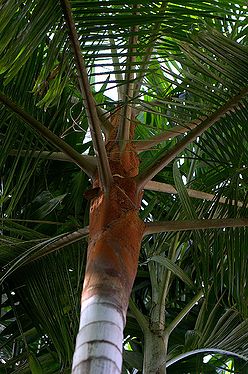 Gold Coast, Hinterland, Queensland. Photo by Daryl O'Connor | |||||||
| Scientific Classification | |||||||
| |||||||
| Synonyms | |||||||
|
| |||||||
| Native Continent | |||||||
|
| |||||||
| Morphology | |||||||
| |||||||
| Culture | |||||||
|
| |||||||
| Survivability index | |||||||
|
| |||||||
| Common names | |||||||
|
| |||||||
Contents
Habitat and Distribution
Said to occur in West Madagascar, but no voucher specimens from the wild are known. (1995).Description
A medium sized, solitary palm with distinct rusty brownish-orange colored crownshaft that sports a fuzzy tomentum from which it's common name, The Teddybear Palm, comes from. The trunk can swell to a girth of about 6 inches and is distinctly ringed with the newest parts being green covered in a white powder. The leaves are exceptionally long with virtually no petiole. Often the leaflets get bent around in the wind and are held at various angles giving this palm a bit of a disheveled look, but the overall beauty is still not compromised. (J. Dransfield and H. Beentje. 1995)/Palmweb.
Solitary palm. TRUNK to 10 m high, 25 cm in diam., slightly flared at the base; internodes 12 cm, nodal scars 2 cm, white. LEAVES about 15 in the crown, porrect; sheath partially open in outer leaves, about 62 cm long, 5 mm thick, covered in dense rusty brown tomentum, with auricles 3.5 cm high; petiole 17 cm long, 7-9 cm wide, channelled adaxially, densely tomentose but glabrescent; rachis to 4 m long, proximally channelled and tomentose, more distally becoming flattened and eventually keeled distally, glabrous distally; pinnae up to 103 on each side of the rachis, regular, slightly drooping, green, linear, straight, acuminate, the proximal 55 x 0.5-0.8 cm, median 85 x 4 cm, distal 55 x 0.5-0.8 cm, glabrous but for some ramenta on the proximal part of the midrib abaxially, main veins 3. INFLORESCENCE interfoliar becoming infrafoliar in fruit, branched to 3 orders, to 1.7 x 1.4 m; peduncle to 65 cm long, 11 cm in diam. proximally, 3-6 cm in diam. distally, flattened, reddish tomentose over green; prophyll ± woody, about 43 cm, borne at 12 cm above the base of the peduncle, about 12 cm wide, tomentose; peduncular bract deciduous, woody, inserted at 26 cm from the base of the peduncle, to 70 x 10-15 cm, reddish tomentose; two smaller peduncular bracts present near the apex of the peduncle, to 17 cm long, tomen-tose; rachis 100 cm, flattened, grey-tomentellous, with 24 first order branches; rachis bracts to 3 cm long; rachillae spreading, to 30 cm long, 3 mm in diam., green; with distant triads in pits; rachilla bract 0.5-0.75 mm high. STAMINATE FLOWERS with sepals 2-2.5 mm, keeled, truncate; petals on a 1 mm high receptacle, 2 x 1.5-1.75 mm, ovate, acute; stamens said to be connate for 1.75 mm, filaments 0.8-1 mm long, anthers 1 mm long, dorsifixed?; pistillode 1.75-2 mm, columnar. PISTILLATE FLOWERS with sepals 2 mm; petals 3 x 3 mm; gynoecium 4 mm high, 2-2.5 mm in diam., with 1 mm long stigma lobes. FRUIT globose, dark brown, 10-12 mm; endocarp fibrous, the fibres anastomosing rather intensely. SEED 8.5-10 x 8.5-9 mm, globose, pointed at the base, rounded at the apex, with a subbasal depression corresponding to the embryo; ruminations of the endosperm irregular, to 3.5 mm deep and up to half the diameter of the seed wide. EOPHYLL pinnate. Close to D. lastelliana but differs in rachilla bract (thinner in leptocheilos), and fruit/seed size. (J. Dransfield and H. Beentje. 1995)/Palmweb. Editing by edric.
Close to D. lastelliana but differs in rachilla bract (thinner in leptocheilos), and fruit/seed size. Differences enumerated in the protologue with another species of Dypsis (it is unclear which one). (J. Dransfield and H. Beentje. 1995)/Palmweb.
Culture
Loves water and responds well to fertilizer. Grows in bright filtered light to full sun but can get leggy and ratty looking if grown in lower light levels, therefore full sun tends to produce a more beautiful palm. Can handle a light frost with damage but usually will recover with no lasting effects. Cold Hardiness Zone: 10a
Comments and Curiosities
Some D. leptocheilos exibit a heel and some don't.
Conservation: Unknown, until the status in the wild has become more clear. (J. Dransfield and H. Beentje. 1995)/Palmweb.
- IMAGE GALLERY
Fallbrook, CA. Hyophorbe Lagenicaulis, California grown and gone through 6 winters now in this spot. the low has been 29 since I've lived here. behind the hyophorbe is a Dypsis Plumosa. Across the walkway is Kentiopsis Pyriformis. There's a large Kentiopsis Oliviformis back there, another Veitchia Spiralis, then Dypsis Leptocheillos and in the front right, another Kentiopsis Pyriformis. Photo by Jason Dunn.
H.P. Leu Gardens, Orlando, FL., "This is the Teddy Bear Palm, Dypsis leptocheilos, at Leu Gardens. It is around 20ft tall and is flowering for the first time. Amazingly this tender palm was planted back in July 1994 ! It has survived down to 26F (Feb. 1996). It originally grew under a large Laurel Oak. That tree blew over in a storm almost 3 years ago. So it and other palms in this area are now in the open. This palm and a nearby 15ft Dypsis lastelliana were stripped of most of the fronds when the tree fell. They were both stunted for about a year and have since grown out of it." Photo by Eric S., Botonist H.P. Leu Gardens.
H.P. Leu Gardens, Orlando, FL., "This is the Teddy Bear Palm, Dypsis leptocheilos, at Leu Gardens. It is around 20ft tall and is flowering for the first time. Amazingly this tender palm was planted back in July 1994 ! It has survived down to 26F (Feb. 1996). It originally grew under a large Laurel Oak. That tree blew over in a storm almost 3 years ago. So it and other palms in this area are now in the open. This palm and a nearby 15ft Dypsis lastelliana were stripped of most of the fronds when the tree fell. They were both stunted for about a year and have since grown out of it." Photo by Eric S., Botonist H.P. Leu Gardens.
H.P. Leu Gardens, Orlando, FL., "This is the Teddy Bear Palm, Dypsis leptocheilos, at Leu Gardens. It is around 20ft tall and is flowering for the first time. Amazingly this tender palm was planted back in July 1994 ! It has survived down to 26F (Feb. 1996). It originally grew under a large Laurel Oak. That tree blew over in a storm almost 3 years ago. So it and other palms in this area are now in the open. This palm and a nearby 15ft Dypsis lastelliana were stripped of most of the fronds when the tree fell. They were both stunted for about a year and have since grown out of it." Photo by Eric S., Botonist H.P. Leu Gardens.
H.P. Leu Gardens, Orlando, FL., "This is the Teddy Bear Palm, Dypsis leptocheilos, at Leu Gardens. It is around 20ft tall and is flowering for the first time. Amazingly this tender palm was planted back in July 1994 ! It has survived down to 26F (Feb. 1996). It originally grew under a large Laurel Oak. That tree blew over in a storm almost 3 years ago. So it and other palms in this area are now in the open. This palm and a nearby 15ft Dypsis lastelliana were stripped of most of the fronds when the tree fell. They were both stunted for about a year and have since grown out of it." Photo by Eric S., Botonist H.P. Leu Gardens.
External Links
References
Phonetic spelling of Latin names by edric. Edit by João Santos Costa
Special thanks to Geoff Stein, (Palmbob) for his hundreds of photos.
Special thanks to Palmweb.org, Dr. John Dransfield, Dr. Bill Baker & team, for their volumes of information and photos.
Glossary of Palm Terms; Based on the glossary in Dransfield, J., N.W. Uhl, C.B. Asmussen-Lange, W.J. Baker, M.M. Harley & C.E. Lewis. 2008. Genera Palmarum - Evolution and Classification of the Palms. Royal Botanic Gardens, Kew. All images copyright of the artists and photographers (see images for credits).
Dransfield, J. & Beentje, H. 1995. The Palms of Madagascar. Royal Botanic Gardens, Kew and The International Palm Society.
855 222 7342
Many Special Thanks to Ed Vaile for his long hours of tireless editing and numerous contributions.

